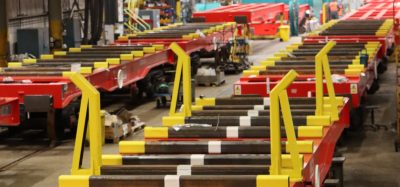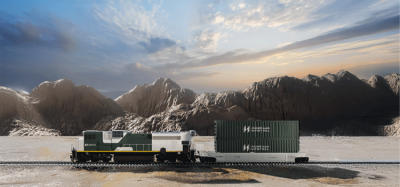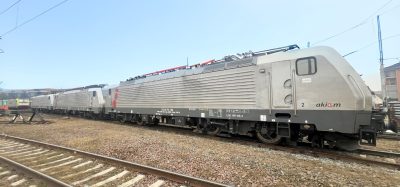Committed to delivering a promise
Posted: 28 November 2006 | | No comments yet
Having won their inaugural contract hauling Infrastructure trains for Railtrack, Freightliner Heavy Haul have been servicing the UK railway network for over seven years. In an interview for Global Railway Review, Mark Anderson, Senior Operations Manager of Freightliner Heavy Haul, explains the company’s commitment to delivery, their “reliability as standard” motto and how they have been entrusted to operate the £25 million state-of-the-art High Output Ballast Cleaner (HOBC) – the most expensive piece of machinery ever to grace the rail network.
Having won their inaugural contract hauling Infrastructure trains for Railtrack, Freightliner Heavy Haul have been servicing the UK railway network for over seven years. In an interview for Global Railway Review, Mark Anderson, Senior Operations Manager of Freightliner Heavy Haul, explains the company’s commitment to delivery, their “reliability as standard” motto and how they have been entrusted to operate the £25 million state-of-the-art High Output Ballast Cleaner (HOBC) – the most expensive piece of machinery ever to grace the rail network.
Having won their inaugural contract hauling Infrastructure trains for Railtrack, Freightliner Heavy Haul have been servicing the UK railway network for over seven years. In an interview for Global Railway Review, Mark Anderson, Senior Operations Manager of Freightliner Heavy Haul, explains the company’s commitment to delivery, their “reliability as standard” motto and how they have been entrusted to operate the £25 million state-of-the-art High Output Ballast Cleaner (HOBC) – the most expensive piece of machinery ever to grace the rail network.
The national rail network, covering over 20,000 miles of track, is a behemoth. The preservation and enhancement of its’ apparatus is a feat of equal proportions. From engineering, to transit services, to the laying of ballast and track, it is imperative that the operators asked to handle Infrastructure work have a track record for service, reliability and above all, delivery.
Early days; never late
Freightliner’s Infrastructure work began in Crewe, when three locomotives were assigned the task of hauling Infrastructure wagons to work on the £7.6b West Coast Route Modernization programme on the West Coast Main Line. With 40% of all Freight using it at some point in its’ journey, the WCML is the busiest mixed traffic route in UK. As a result, major work on the route had been some 35 years in waiting.
Within just 12 months, the number of locomotives assigned to the sector within the company had ballooned to 20. The annual contract with the National Delivery Service (part of Network Rail) stipulates that Freightliner supply 70,000 operational hours per year. Over the past three, they have breached that number.
Capitalizing on their expanding resource base, Freightliner provides a range of services including train preparation, dispatch, possession management and wagon positioning.
“We deliver a package of rail haulage, planning, support and our promise” says Anderson. “Over the last four years, we have based our contract on an ever-growing scenario. Over the next four, we will continue to branch out.”
The ever-growing scenario is rooted in reality, not optimism. A study issued by Network Rail in September forecast that over the next 10 years growth in rail freight would exceed 60%. Finding extra capacity on the network, particularly at pinch points, has thus become a priority. The vast majority of options involve Infrastructure work; this is already illustrated by the fact that Infrastructure services currently account for 7% of gross freight tonnage on the network.
Having spread their operations to the South, in December 2004 Freightliner secured a contract at short notice to service the Western Region of the UK. Like the WCML, the Western Region (which includes routes extending from Reading to Wales and the Southwest) was in desperate need of repair, with rail and sleepers being among the oldest on the network. Track maintenance spend on the Great Western Line alone will total 33, 31 and 28 million pounds respectively over the next three years; track renewal estimates post similar figures. In an attempt to match track quality with traffic volume, High Output Equipment is being deployed on the most intensively used parts of the route, which includes Reading to Exeter, and Bromsgrove to Taunton via Bristol. To maintain stable Infrastructure on the more rural branch lines less intensive, targeted renewals are being carried out. Freightliner is involved at all levels of the operation.
Meanwhile, Heavy Haul secured a High Output contract to conduct track renewals on the East Coast Main Line, and later the Track Renewal Train (TRS), also in the Western Region. Last August, the company began operating a HOBC train out of Doncaster. The locomotives were derived from Midland Road in Leeds, now the site of independent subsidiary Freightliner Maintenance.
Heavy Haul currently have 73 class 66 locos on their books (with eight more on order), supplemented by a fleet of 893 wagons. As Anderson explains, despite the size of the fleet, availability fluctuates as readily as the trains themselves run – at present, one every ten minutes:
“There is a great deal of ebb and flow of wagon types that need to be brought from one end of the country to the other. Simply put, it’s an elaborate juggling act.”
It is, after all, a national fleet of wagons, partly owned by Network Rail. Indeed, Freightliner have leased wagons to Network Rail in order to support the huge movements of wagons and materials required for Engineering and Infrastructure trains.
“There is tremendous competition for resources, locos and drivers.” Anderson continues. “We’ve had weekends when we’ve had 40 locos active instead of the contracted 20. We don’t have the luxury of regular timetables. We attempt to negate these difficulties by robust planning.”
One example of this is to prepare available locos in advance, moving them to available sidings close to site before the weekend, when the commercial fleet is less active. The latest plan is to conduct more maintenance and renewal work during the week through longer night possessions, coupled with the allocation of replacement bus services along underutilized corridors by passenger operators. At present, because of the time it takes for the set up and dismantling of high output equipment (up to 50% of total working time) this represents an outstanding opportunity.
A sleeping giant
Heavy Haul’s Infrastructure and Engineering work consists of three core elements: High Output trains (the HOBC and TRS), the servicing and support of these trains, and shunting operations. The nexus of their operations remains in Crewe, where all resource planning activity, from locomotive movements to staff allocation is coordinated. Crewe is also the site of the largest and best performing Local Distribution Centre (LDC) at Basford Hall.
Weighing up to 3,500 tonnes in loaded condition, the HOBC is a goliath. To mitigate the risk of haulage failure based on excess weight, a formation known as a Top and Tail is utilized. Akin to a backup parachute, this involves placing a locomotive at each end of the train.
With its’ steep gradients to negotiate, the Western Region has thrown up an extra level of difficulty. Heavy Haul secured special dispensation from Network Rail to operate not one, but two locomotives at both the front and back of the HOBC train. Should the engine stall on a bank, the presence of a driver and radio operator in each cab curtails the risk of disastrous engine failure. When it costs £120,000 alone to operate the HOBC, it is a necessary expense. At times, therefore, up to 18 drivers have been required to haul the HOBC and its’ supporting services. At present, Heavy Haul operates the HOBC nationwide every day.
Eight months after introducing the HOBC in the Western Region, Heavy Haul began operating the TRS; this involves a rail delivery train situated beside the track, a team of engineers who “pop” out and replace the old rail, and a rail recovery unit that collects and exports the redundant material from the site. Due to operational constraints, TRS operations were switched to the Freightliner’s Intermodal Depot at Wentloog, near Cardiff, in April. This helped minimise the danger of late arrival – an inherent risk where longer distances are involved. For the HOBC, portions of the train are tripped to different locations for spoil discharge and ballast replacement. As a contingency, more than one location is available for this. Some locations, though, can handle much more than others.
Reading the future
To service the Western Region contract, Heavy Haul needed to compartmentalize their resources. High Output trains, because of their size and weight, pose a tremendous challenge in terms of marshalling, reloading and maintenance – far beyond the capabilities of a typical depot or LDC. The company was stuck between a rock and a hard place: either compromise the integrity of the Bulk Freight business by shifting extra resources to High Output trains, or risk failing with their delivery, thereby causing congestion and a disastrous loss in both short and long term productivity on the network.
Anderson adds: “Haulage failure isn’t an option. Not only is the train affected; there are huge amounts of track workers, yellow plant and associated resources waiting on site for materials.”
For the HOBC, pre-determined limits are set on permissible departures. If these limits are exceeded, the train will not run. It is the lesser of two evils: better to cancel the train outright than risk the possibility of it being cancelled 30 minutes down the line when associated work has been set in motion.
Consequently, to deliver on their word, the company developed the High Output Operations Base (HOOB), specialised sites devoted to the provision and maintenance of High Output trains. The first of these was stationed at Reading, a fulcrum between the South East, the Midlands and the West, where the initial bulk of Freightliners’ work was to be carried out.
Heavy Haul was responsible not only for punctual haulage and presentation of High Output trains to site, but for the provision of shunting within Reading Yard and the servicing of equipment upon its return. To augment train crews from Bristol and Eastleigh, a new train crew depot was based within the base, while maintenance plans were changed to readily accommodate mobile fitters visiting the site. This limited locomotive downtime, meaning that in the event of a loco malfunction a standby locomotive could be stepped up – and stepped in – almost immediately.
“Turnaround is everything.” Anderson observes.
“The paths on the rail network to get these trains onto site are complex. A 100 plus SLU train takes long time to get moving, and can’t fit through the normal loops on the network. Once these trains leave their special sidings, they get in the way. That’s why timely departures are critical.”
Consequently, for their Infrastructure work, Freightliner operates what Anderson describes as a “performance monitored regime”. There is a weekly performance meeting: a teleconference in which upcoming loco plans are locked in, and any failures discussed and attributed. Thus far, the discussions have been short.
Westward Ho!
Reading proved an outstanding success for Heavy Haul. Due, however, to the sheer volume of the workload in the Western Region (estimates indicate the project will not be finished until 2011) Freightliner soon began to look for another site to supplement their High Output operations. Not only are the pathway options of High Output trains severely restricted, but so too are the yards that can accommodate them. One of these though was at Fairwater Yard, just West of Taunton, ideally placed and furnished to form the new hub of Heavy Haul’s Infrastructure work in the West. In addition, with the HOBC extending as far as Exeter, at 150 miles Reading was simply too far to make the operation viable.
Anderson explains; “Through wider geographical coverage, the spread of depots has enhanced our flexibility. By taking one more link out of the chain, Taunton guarantees that risks due to distance, time and capacity are kept to an absolute minimum.”
With a life-span of two and a half years, Taunton ran its’ first train, a TRS, on the 25th of September to Brent Knoll. Long after the repair work on the network is done however, this base, like Reading before it, will help consolidate Freightliner’s commercial and engineering activities.
Since they began working on the Western Region, Freightliner have vindicated their promise, with no loss being attributed to haulage failure. Nonetheless, even with the HOOBs in place, much work remains to be done.
“As we grow, we continue to experience the reality of the discrepancy between what you need, and what you get. The difficulty for Freightliner now is the logistical support of these out-based locations.” Anderson concludes.
“Delivery is just one part of the job. Moving the train is easy compared to the support required to make that train run in the first place. The good news is we do both.”






